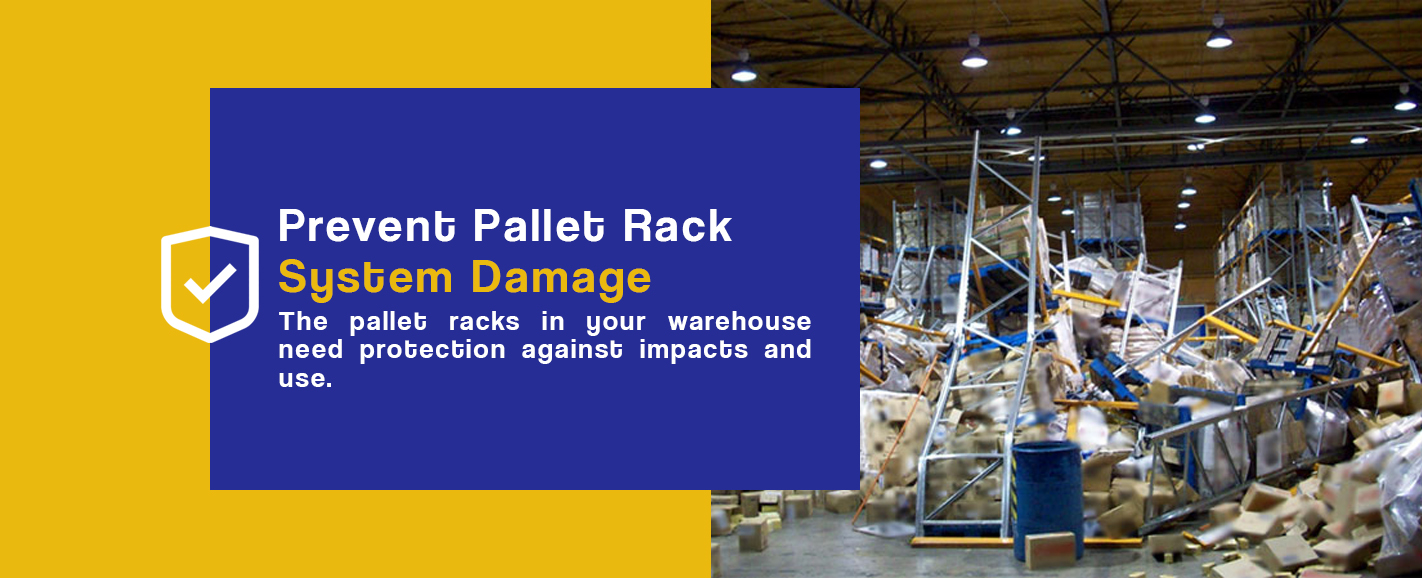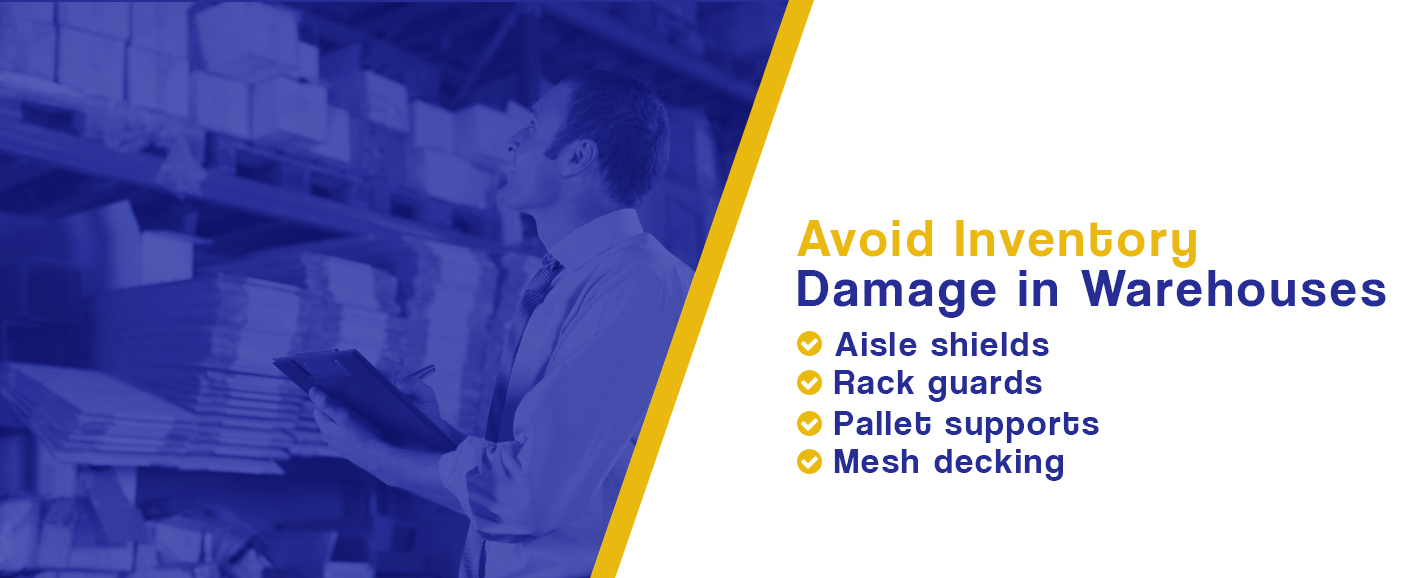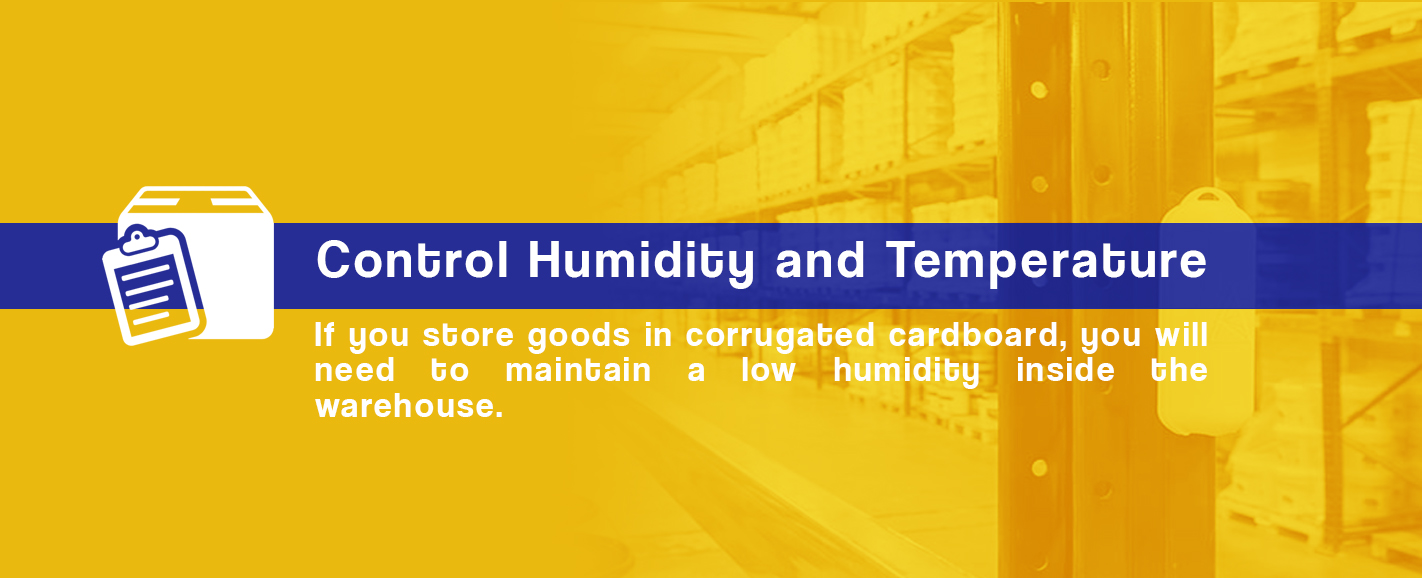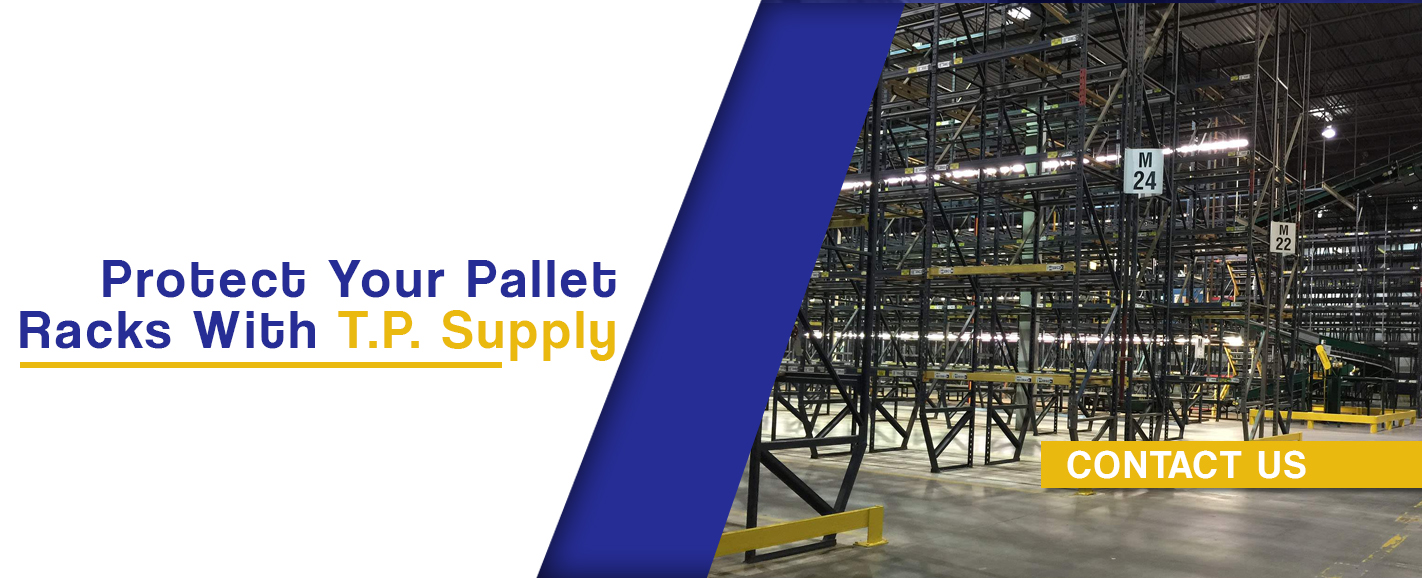Preventing Pallet Rack and Inventory Damage in Warehousing

Keeping your warehouse’s inventory and storage systems safe and secure protects you from profit and productivity losses. Preventing pallet rack damage starts with having the right parts to keep the racking system safe from harm during the daily operations of your facility. Additionally, you must also protect inventory from the elements in all areas of your warehouse. You’ll need more than just pallet rack protectors to secure your stock. Discover the ways you can invest in your warehouse to extend the lives of your storage equipment.
View our safety & security products
1. Reduce Warehouse Damages
Warehouse damages to your storage equipment or products do not have to happen. You can cut the likelihood of losses in your facility through several means. In some cases, the methods will overlap to protect both your storage racks and the products stored on them.
The problem with warehouse damages comes from increased traffic and inventory. With more forklifts and products, the chances rise for a collision between a truck and a pallet rack. Damage from forklifts often occurs in the bottom 12 inches of shelves. You will need to protect this area from damage with rack protectors. But even higher places such as at the joints of the beams and uprights can sustain damage when forklifts reach up for pallets from the higher levels.
Protecting your racking systems is one way to prevent harm to products stored on them. You will also need to take care of the products themselves, especially when they sit in exposed areas. The elements can ruin many products unless you’re proactive in keeping the goods dry.
2. Prevent Pallet Rack System Damage
The pallet racks in your warehouse need protection against impacts and use. You have several options at your disposal to increase the longevity of your pallet racks and make them more secure for the products stored on them.
- Column protectors: Column protectors come in heights of 12 inches to 24 inches. These metal protectors fit around the bases of your rack uprights to prevent damage to the uprights from forklifts and foot traffic.
- Rack Pals: Rack Pals are similar to column protectors, but instead of just blocking the base of the column, these cover the column and the entire rack as well. You can select wrap around or double-sided Rack Pals in sizes from 24 inches to 54 inches.
View Our Pallet Rack Accessories

Aside from equipment, there are other ways you can protect your pallet racks in your warehouse. Widening the aisles to allow for easy maneuvering of forklifts also reduces the chances of collisions on your pallet racks. Label the aisle width and height clearances to inform workers of the space they have available for safe movement of products or forklifts. To also make it easier for the drivers, keep the aisles clear of debris and pedestrians. Mark out separate lanes for those on foot and vehicles. These two lanes will prevent personnel from moving outside the corridor into a rack to avoid hitting a person or vehicle.
The drivers of your forklifts also play a role in the safety of your racks. Ensure you thoroughly train all forklift operators in moving the vehicle throughout your facility for both safety and adherence to OSHA regulation 1910.178 (I)(1)(i). When untrained people use forklifts, the chances for accidents and damage to the vehicle and racks increases. Don’t put your warehouse or workers at risk.
3. Know Your Weight Class
Pallet racks and beams have weight limits. Always order storage systems that exceed the highest load you will put on them. Additionally, make the weight capacity information for your pallet racks available to your employees. Doing so will prevent your workers from overloading the shelves, which could cause severe injury if an overloaded stand collapses. Consider labeling the racks with their weight limits. Having the loads and racks marked will prevent employees from overburdening the racks with too much weight.
4. Inspect Your Racks
The racks you store pallets on are only as good as their construction. Over time, bolts may loosen, which could pose a hazard to your facility. Schedule regular inspection and maintenance of all your warehouse’s racks. Replace bent, rusted or otherwise damaged components. These include beams, uprights, bolts and accessories. Tighten bolts and other connectors. If you have accessories such as Rack Pals or aisle shields, check those for signs of wear as well. Some accessories, such as wire mesh decking, have weight limits that could reduce if the part becomes worn. Your workers may overload a worn rack without knowing it. Regular inspections can prevent disaster in your facility by keeping your storage system in prime condition to support its full capacity.
5. Avoid Inventory Damage in Warehouses
Inventory damage may occur in many ways in your warehouse. Sometimes, the fault is not your own. Between two and 11 percent of goods coming into distribution centers already have damage. But for most goods you store, you must prevent harm from happening to them. Protecting the products from falls and the elements could make the difference in how many parts reach their destination unscathed. There are several pallet rack guards you can use to prevent damage from falls.

- Aisle shields: Aisle shields prevent products from falling off pallets into the aisles. While these shields protect the items you keep stored, they also protect your workers from getting hit by falling boxes or bags from pallets. Since this shield prevents products from falling off the racks, you have less worry about products getting damaged from hitting a catch net or the ground. Additionally, products that stay on the rack do not become lost if they fall from the pallet.
- Rack guards: Rack guards also keep products from falling into the aisles. The see-through design of rack guards and aisle shields makes it easier to see which products you have stored on the shelves. Like aisle shields, rack guards protect your employees as well as the goods you have stored on racks in your warehouse.
- Pallet supports: Adding pallet supports increases the support under the pallets, which would otherwise only have support where they rest on the beams. Crossbars are ideal for use under old pallets that might sag from the weights of their loads. Even newer pallets need extra support in the middle if they are holding up too much weight. As with any accessory for your racking system, never undersize the components. Always use parts designed to hold more weight than they will need to.
- Mesh decking: Though pallets hold most of your products, sometimes boxes or bags may fall off the pallets. To keep them from slipping to lower levels or the floor, use mesh decking on the racks to catch the dropped items. Mesh decking will also prevent products from falling into the aisles and creating a trip hazard. When selecting wire mesh decking, avoid sagging by purchasing decking with a capacity higher than the products you store on it. We have wire mesh decking with load capacities from 2,000 pounds to 3,500 pounds.
View Our Aisle Protection Products
With the right accessories for your storage racks, you can reduce the number of products that get damaged in your facility. Cutting down on product damages will make your suppliers happy to continue doing business with you. Fewer product damages also lessen your liability and costs you incur. Your workers will even feel safer at work since they will have less concern about improperly stored products falling from their pallets.
6. Improve Lighting
Check the lighting in your warehouse. If you don’t already have adequate lighting, now is the time to install it. All workers need to see the labels on products to avoid pulling the wrong containers. Removing the incorrect products from the shelves could damage the products when your workers must replace them on the rack. Every time someone moves a product, the chances for damage increase. Better lighting can prevent excessive movements of containers from the racks, which could reduce product damage.
Poor lighting may also contribute to accidents in the workplace. If a worker falls, he could also damage products nearby. Reducing accidents protects your workers and the products you store in your warehouse. You may require updated light fixtures if you add storage racks, which could create new shadows with your existing lighting. If you’re concerned about the costs of adding more lighting, use energy-efficient lights and fixtures in addition to natural light. Repainting the ceiling in your warehouse increases the amount of light reflected off it.
7. Train Employees in Proper Procedures
How carefully the products get picked from shelves depends exclusively on the training of your employees. Too often, workers will pull bagged products from the area closest to them. When employees pull the nearest products to them instead of from the top, the action puts the bags in a precarious position on the pallets. Poor positioning of the containers encourages falls and spills. Train your workers to always pull individual packets from the top to avoid disrupting the stacks on the pallets. Bagged goods are also different from boxes. Since the bags lack exterior integrity, you should not use machinery if possible to move bags. A forklift can cut through a bag instead of reaching for a pallet. Vehicles, though, work well to move intact boxes.
8. Protect Against the Elements
Temperature, moisture and humidity can severely damage products in your facility. Depending on how you store the items, you could increase their exposure to these harmful elements. Learn the best ways to protect the products under your care from the elements with the right storage methods and accessories. Planning for inclement weather and natural disasters goes a long way toward keeping the goods in your facility safe from the unexpected.
9. Plan for Natural Disasters
Depending on where your warehouse is located, you may have a higher chance of dealing with certain natural disasters. For instance, not all areas of the country deal with earthquakes, but those that do must take precautions to keep racks from collapsing. If you’re in an area with seismic activity, choose heavy-duty racks with extra bracing. Aisle shields or rack guards are also necessary to keep products on the racks in the event of an earthquake.
In flood-prone areas, keep all products at least a foot off the floor. If you have the luxury of a day or two warning of storm surge from a hurricane, you can move the products higher off the ground. But it’s best not to store anything directly on the ground to reduce the time your workers need to prepare your warehouse for a disaster. Occasional flooding from rivers and torrential downpours can happen without warning. Even if you have insurance to cover lost products of a catastrophe, it’s best not to have to use the policy to prevent a rise in your rates and a loss of business.
10. Control Humidity and Temperature
If you store goods in corrugated cardboard, you will need to maintain a low humidity inside the warehouse. After 30 days of storage, corrugated cardboard loses 40 percent of its strength. The loss increases to 71 percent as the humidity rises from 50 to 95 percent. The moisture from high humidity levels combined with heat may erode the glue holding the tape that keeps the box intact. Lowering the humidity in your facility could keep cardboard storage containers from falling to pieces.

Humidity and rain may also affect your shelving. Use rust-proof racking and decking to keep rust at bay. Over time, rust can wear through metal, causing it to lose its integrity. The result could be sagging or collapsed shelving. Even if you choose weather-resistant parts, always conduct thorough inspections of your storage units. Regular checks will identify wear before it has a chance to cause a failure of the structure.
11. Keep Rain Away
Rain can ruin a shipment waiting at the loading dock. Keep tarps on hand and always cover everything waiting on trucks if it’s overcast. It’s better to be safe than have a shipment soaked from an unexpected rainstorm. Use the tarps, too, if it’s raining during unloading from a truck. Cover all products while they are still inside the delivery vehicle before moving them through the rain into your warehouse. Even exposure to water for the short trip from the truck to the warehouse could ruin some products. Don’t take the chance.
If possible, consider constructing an overhang near your dock to stack products awaiting shipment. The overhang will protect the containers until you load them onto the truck. But because you cannot control the conditions outside, especially temperature and humidity, never leave products outdoors too long. In addition to hazards posed from the elements, shipments left near the dock pose a security hazard for your warehouse.
Protect Your Pallet Racks With T.P. Supply
Maintain your warehouse storage equipment by protecting your pallet racks. At T.P. Supply, we have the pallet rack protection items you need. Our easy-to-navigate website makes it simple to find the right rack accessories to fit your pallet racks. We also have rack system components to create the storage your facility requires. If you need more information about us or our products, contact us. We want to help you maintain your warehouse and its equipment.


